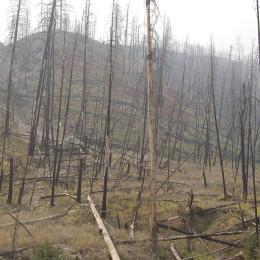After the Fire - Seeding
Re-establishing permanent vegetation after a wildfire provides long-term erosion control, may restore lost habitat values, and may help suppress weed invasion after a wildfire.
Loss of vegetation leaves land vulnerable to increased runoff, erosion, and sedimentation. It also increases weed spread and growth; degrades habitat; and impairs forest regeneration.
It takes time and favorable climatic conditions to establish vegetation from seeding operations. Therefore, it may be six months or a year before the full benefits of seeding are realized. Seeding after wildfire must be combined with other land treatments, such as mulching or contour felling trees, to provide an immediate erosion control benefit, and to assure the seed remains in place until it can germinate.
When is the right time to seed after a fire?
Seed grasses and forbs in late fall or late winter (even if there are a few inches of snow). To improve the probability for a successful seeding, use a national or local weather services to time seeding within 30 days of precipitation. The prime time to seed is immediately prior to the ground freezing. Trees or shrubs should be planted in the early spring when plants are dormant.
What areas need to be seeded?
Severely burned sites should be seeded to decrease the likelihood of erosion and sediment movement down slopes, to discourage weed invasion, and to fulfill management objectives.
The area to be seeded should have adequate soil to support vegetation. Seeding slopes steeper than 60 percent is difficult, and not especially effective for reestablishing permanent vegetation. These steep slopes may need the use of erosion control mats or hydroseeding with a tackifier to keep soil and seed in place. These methods are expensive so use only on critical areas.
Vegetation in areas of light and moderate burn severity will recover on its own after a wildfire, and seeding perennial species is usually not necessary. Seeding a short-lived species may provide some ground cover, stabilize soil, and reduce weed spread until permanent vegetation reestablishes.
How should the seeding be done?
Most post-fire seeding is done by hand-held equipment, use of ground equipment, or by aircraft. Landowners can seed small areas using a hand-crank broadcast seeder. If there is equipment access to the site and the slope is less than about 30 percent, it is usually easier and more cost effective to seed areas larger than 1to 2 acres with broadcast seeders mounted on all-terrain vehicles or tractors. Aerial seeding is used on large contiguous areas and on slopes too steep or otherwise inaccessible for ground equipment. Seeding with a hydromulching operation should be considered when revegetation is protecting high value properties immediately downstream of the area being seeded. If fire seals or rain smooths soil surface, then it may be helpful for small areas to rake by hand and for larger areas to roughen up the surface mechanically prior to broadcast seeding, for improved success.
What species should be used?
Native species seed mixes are well adapted to site soils and climate. Perennial native grasses and forbs can be slower to establish than introduced species but provide long-term cover for reseeded sites. Short-lived perennials can be added to the seed mix to provide immediate benefits. For example, slender wheatgrass is a short-lived native grass that establishes quickly. Over time, slender wheatgrass cover will decrease as other native species fill the site.
Small grains are useful when quick establishment is key; however, they only provide one year of protection. Revegetate with sterile annual species where perennial grasses will recover naturally, including moderately burned sites with slopes greater than 15 percent. For severely burned areas it would be appropriate to include perennial species with the small annual grains. When purchasing seed, use certified seed of a known variety to get the best results. If a specified variety is not available, be sure the original seed (germplasm) source is compatible with the precipitation, soil, and elevation of the revegetation site. Check the seed label to be sure seed does not contain any noxious weeds.
Most seeding recommendations are based on drill seeding rates and expressed in terms of pure live seed (PLS) pounds per acre (PLS = percent Purity x percent Germination). Broadcast rates for burned areas should be at least double the drill seed rates.
What variety of seeds should be used?
Contact the local NRCS, Extension Service, or conservation district office for recommended species, varieties, and seeding rates.
What should be done along with seeding?
Mulching will stabilize the soil surface to prevent movement of soil particles and loss of seed. Use certified weed-free straw or grass hay mulch applied at 70 pounds per 1,000 square feet. (about 43 bales per acre). Seed the site before applying mulch to ensure the seed is in contact with the soil. Do not include fertilizer because it will promote weed growth. Use netting to keep the mulch in place on small areas of steep slopes or use erosion control blankets that act as mulch. Hydroseeding with a tackifier can also provide site stability. It is expensive but it can be accomplished in one operation. Maintain seeded areas by repairing any spots of seeding failure with new seed and mulch, if possible.

CAUTION: After a fire, many trees are weakened from burning around the base of the trunk. These trees can fall over or blow down without warning. Shallow-rooted trees can also fall. Therefore, be extremely alert around burned trees.
Additional Information
Montana Forestry Resources
NRCS Montana guides for forest management and wildfire recovery.
NRCS Forestry Web Page
Forestry and agroforestry information and technical resources that apply to all States.

